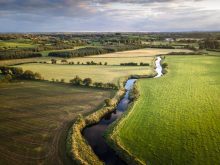Nova Scotia producers who farm near the Bay of Fundy still use a dike system that was initially built 400 years ago
MASSTOWN, N.S. — Agricultural water management in Nova Scotia relies on a centuries-old method of keeping salt water at bay.
The province’s dikeland system was established about 400 years ago and is still in use on tidal rivers in the Bay of Fundy area.
It protects about 45,000 acres of farmland, as well as critical infrastructure and communities.
Read Also

Canola oil transloading facility opens
DP World just opened its new canola oil transload facility at the Port of Vancouver. It can ship one million tonnes of the commodity per year.
Climate change is causing water levels to rise, but the province itself is sinking, said the provincial government. The relative sea level change is notable and by 2100 is expected to be about one metre. That presents challenges for the dike system.
Acadian settlers brought the concept from France as early as the 1630s.
“They started building the berms, figured out how to drain the water out, and I think they invented the aboiteau,” said Steve Tattrie, director of animal and crop protection with the provincial agriculture department.
“Here we are 400 years later still maintaining those systems.”
An aboiteau is a wooden sluice built into a dike. It traditionally had a wooden, hinged door or was made from logs.
It swings open at low tide to let fresh water to drain away from agricultural land and then swings shut under the pressure of high tide to keep the salt water out. Over time, saline land was reclaimed by the fresh water and used to produce hay and crops on the marshland.
Standing near a now-steel aboiteau with gates on the Cobequid system, Tattrie said the Acadians knew they had to either cut down less-fertile forested land or develop the rich marshland.
“This was obviously the better solution for them,” he said, noting farmers still produce “amazing” crops on these lands.
There are four main systems on the Cobequid, the Annapolis River, the Avon River and the Cumberland Basin that borders New Brunswick.
“There’s about 240 kilometres of dikeland that we protect and in that there’s over 250 of these aboiteaux that are draining the land,” Tattrie said. “It’s about 18,000 hectares (45,000 acres) of different types of land.”
About 15 employees work to maintain the systems by mowing, cleaning debris from the marsh and dealing with erosion problems.
The aboiteaux require ongoing maintenance, too, because they are always opening and closing. Things can get stuck in them, they require relining or they leak and need new seals.
Different weather causes different issues. Last year was rainy and caused erosion. This past year was dry, leading to problems with siltation.
During an early October visit, the amount of silt that had built up meant visitors couldn’t see the gates at this aboiteau.
However, Tattrie and Terry McKay, manager of land protection, said a good rain before the snow this fall would have enough force to sweep silt back out toward the Bay of Fundy.
McKay pointed out the tide comes in and goes out twice a day. That means any work required has to be done within a short window. Land inside the dikes is under federal fisheries control and there is only so much that can be done.
The system fell into disrepair between the 1920s and 1940s when the demand for hay and feed grown on the land dropped.
In 1949, the federal government introduced the Maritime Marshlands Rehabilitation Act and work began to fix the dikes. According to the Nova Scotia government, more than 74,000 acres of dikeland were secured between 1949 and 1970.
Abandoned or idle dikelands provide significant habitat for wildlife and birds and in some cases are managed as wetlands.
In 2019, the province undertook an eight-year upgrade project to improve about a quarter of the 240 km along the Bay of Fundy.
It is expected to help the system withstand storms that are increasing in intensity and frequency, as well as changing sea levels.
A research paper published in 2021 looked at the adequacy of the existing dikes to protect coastal land from rising seas and storm surges.
It noted the dikes themselves were once protected by remnant foreshore tidal wetlands that are now mostly gone.
“Moreover, starved of rich sediments from the bay for so long, many dikelands have subsided, making drainage on them increasingly difficult. The decision-makers that manage the dikes must decide where to reinforce, realign or abandon dikes and related infrastructure,” the study said.
The researchers also said tidal wetlands could be restored.


















